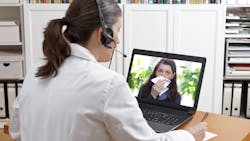Study shows telemedicine was effective during pandemic
An analysis of Kaiser Permanente Northern California telehealth visits that took place early in the COVID-19 pandemic suggests that handling routine health concerns by phone or video is a safe and effective option alongside in-person visits.
The study, published in The American Journal of Managed Care, found low rates of follow-up care required in the seven days after a phone or video visit. Video visits were followed by an in-person office visit in 11.8% of cases, as were 12.5% of phone visits. Just 1.2% of visits by video and 1.5% by phone were followed by a trip to the emergency department.
“This is a reassuring message that both types of telemedicine look like they are meeting patients’ needs well enough that patients are not often returning to the clinic or emergency room or worse, being hospitalized,” said senior author Mary Reed, DrPH, a research scientist with the Kaiser Permanente Division of Research.
The researchers examined 734,442 patient-initiated primary care telehealth visits between March 16 and October 31, 2020, the initial COVID-19 pandemic period when the majority of medical visits being scheduled online by KPNC members were virtual. In-person office visits were available based on a doctor’s recommendation after a virtual visit.
Despite the attention paid to the pandemic-era growth of patients and doctors meeting by video, this analysis of care at the height of pandemic restrictions actually found a substantial amount of care was provided by telephone – 58.4% of telehealth visits.
Lead author Jie Huang, PhD, Division of Research data scientist, said the results support the utility of a simple phone call. “The telephone visit can provide an accessible option to address patient primary care needs for people who may not have technology or knowledge of video without raising safety concerns,” Huang said.
The study also compared medical actions taken during video and phone visits. Video visits had slightly higher medication prescribing (any medication: 37.4% video vs. 33.9% phone; antibiotic: 7.7% video vs. 7.3% phone) and lab and imaging orders: 31.3% video vs. 27.4% phone.
The authors noted both types of telehealth have strengths; video visits may be more efficient for care that benefits from a face-to-face connection or sharing visual information, while phone visits may be more convenient for those without video capability.
Previous research by the study team compared virtual and in-person visits, before the pandemic, and found health outcomes were comparable. Pre-pandemic, KPNC patients were choosing telehealth for primary care 14% of the time. That rate rose dramatically during the early pandemic, and has since declined again, but not to as low as before pandemic shutdowns.
Phone and video visits are likely a permanent feature of the care landscape, Reed said. “These methods of care continue to be strongly used,” she said. “These findings are important because they really reflect the way telemedicine is going to continue to be used in a substantial fashion, rather than as a sort of peripheral option like we saw pre-pandemic.”
